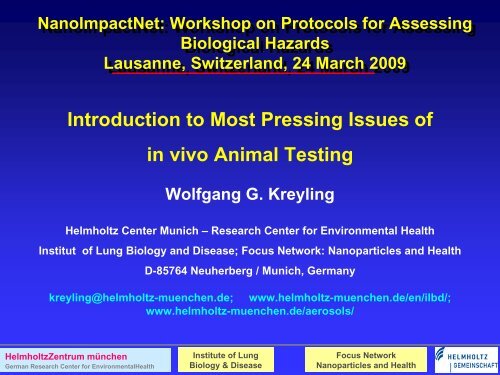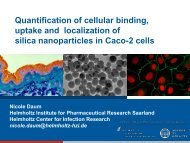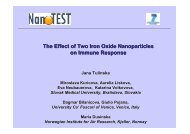Wolfgang Kreyling - NanoImpactNet
Wolfgang Kreyling - NanoImpactNet
Wolfgang Kreyling - NanoImpactNet
You also want an ePaper? Increase the reach of your titles
YUMPU automatically turns print PDFs into web optimized ePapers that Google loves.
<strong>NanoImpactNet</strong>: Workshop on on Protocols for Assessing<br />
Biological Hazards<br />
Lausanne, Switzerland, 24 24 March 2009<br />
Introduction to Most Pressing Issues of<br />
in vivo Animal Testing<br />
<strong>Wolfgang</strong> G. <strong>Kreyling</strong><br />
Helmholtz Center Munich – Research Center for Environmental Health<br />
Institut of Lung Biology and Disease; Focus Network: Nanoparticles and Health<br />
D-85764 Neuherberg / Munich, Germany<br />
kreyling@helmholtz-muenchen.de; www.helmholtz-muenchen.de/en/ilbd/;<br />
www.helmholtz-muenchen.de/aerosols/<br />
HelmholtzZentrum münchen<br />
German Research Center for EnvironmentalHealth<br />
Institute of Lung<br />
Biology & Disease<br />
Focus Network<br />
Nanoparticles and Health
Outline of of pressing issues from my point of of view<br />
• Routes of Nanoparticle intake<br />
• Exposure and dosimetry<br />
• Long-term NP dose estimates<br />
• Controlled NP administration<br />
• NP trafficking back + forth across lung membrane<br />
• Long-term NP translocation<br />
• Mechanisms of NP accumulation in 2 nd target organs (role NP-<br />
protein-complex formation from our biokinetic point of view)<br />
• Toxicological testing in primary vs. secondary target organs<br />
HelmholtzZentrum münchen<br />
German Research Center for EnvironmentalHealth<br />
Institute of Lung<br />
Biology & Disease<br />
Focus Network<br />
Nanoparticles and Health
NP in human lungs<br />
Gehr,1988<br />
1 mm<br />
Alveolar wall<br />
HelmholtzZentrum münchen<br />
German Research Center for EnvironmentalHealth<br />
Nanoparticles (NP): Routes of of Intake<br />
140 m², m , erythrocyte, erythrocyte,<br />
7 µm<br />
Institute for<br />
Inhalation Biology<br />
Focus Network<br />
Nanoparticles and Health<br />
~2 m²<br />
400 m²
Systemic translocation of nanoparticles towards<br />
secondary target organs<br />
Human dose estimate during continuous exposure applying rat<br />
translocation dynamics determined for Ir UFP:<br />
NC (UFP) (10 5 p/cm³) 10 11 p/m³<br />
Daily inhaled volume 10 m³<br />
Deposition fraction 0.3<br />
Insoluble UFP fraction 0.1<br />
Translocated fraction to brain, heart 0.001 (of lung deposit)<br />
(From 6-months 20 nm Ir NP retention study; Semmler et al., 2004)<br />
Retained UFP number in brain, heart ~10 10 UFP/year<br />
Estimated surface area ~1 mm²<br />
(based 15 nm NP assumption)<br />
Estimated mass in brain, heart (lungs) ~10 ng/year ~10 µg/year<br />
HelmholtzZentrum münchen<br />
German Research Center for EnvironmentalHealth<br />
Institute of Lung<br />
Biology & Disease<br />
Focus Network<br />
Nanoparticles and Health
Lomer et al. J. Nutr., 2004<br />
HelmholtzZentrum münchen<br />
German Research Center for EnvironmentalHealth<br />
Particle uptake from GI-Tract<br />
pigment TiO 2<br />
Institute of Lung<br />
Biology & Disease<br />
SiO 2<br />
100 - 250 nm, NP?? nm ?? (SSA > 100 m²/g)<br />
Daily consumption (mg) 4.5 45<br />
Intestinal absorption 0.001 - 0.01<br />
Absorbed PM per day (µg) 4.5 – 45 45 – 450<br />
Absorbed PM per year (mg) 1.6 – 16 16 – 160<br />
Assume 0.5% mass fraction NP<br />
Absorbed NP per year (µg) 8 – 80 80 – 800<br />
Lung deposit of insoluble NP<br />
per year after inhalation (µg) ~10<br />
Focus Network<br />
Nanoparticles and Health
HelmholtzZentrum münchen<br />
German Research Center for EnvironmentalHealth<br />
Inhalation vs. Instillation +Aspiration<br />
inhalation instillation<br />
head<br />
abdomen<br />
Institute of Lung<br />
Biology & Disease<br />
head<br />
head head head<br />
head<br />
• NP inhalation is the gold standard, but NP<br />
dosimetry remains difficult<br />
• NP instillation does not reach all lung areas<br />
aspiration<br />
but NP dosimetry is rather accurate<br />
• NP aspiration does not reach all lung areas<br />
and shows large variable airway deposition<br />
Focus Network<br />
Nanoparticles and Health
HelmholtzZentrum münchen<br />
German Research Center for EnvironmentalHealth<br />
Exposure and Dosimetry<br />
NP Trafficking across Lung Epithelium<br />
Institute of Lung<br />
Biology & Disease<br />
Focus Network<br />
Nanoparticles and Health
NP Trafficking across Lung Epithelium<br />
inhalation<br />
AM<br />
HelmholtzZentrum münchen<br />
German Research Center for EnvironmentalHealth<br />
Airway<br />
epithelium<br />
Acinus<br />
Rapid translocation from surface<br />
Institute of Lung<br />
Biology & Disease<br />
NP<br />
clearance<br />
Airways<br />
NP re-entrain-<br />
ment<br />
Alveolar<br />
epithelium<br />
Semmler-Behnke et al., EHP 2007<br />
Focus Network<br />
Nanoparticles and Health
NP Trafficking across Lung Epithelium<br />
interstitium<br />
Epithelial lining layer<br />
blood erythrocyte<br />
• Translocation into blood is a minor transport mechanism<br />
Courtesy P. Gehr<br />
• But relocation from the epithelial surface to into the epithelium and interstitium<br />
is a prominant transport mechanism including re-entrainment of NP back to the<br />
epithelial surface + macrophage-mediated clearance towards the larynx<br />
HelmholtzZentrum münchen<br />
German Research Center for EnvironmentalHealth<br />
Institute for<br />
Inhalation Biology<br />
Ir NP: Semmler-Behnke et al., 2007<br />
Focus Network<br />
Nanoparticles and Health
HelmholtzZentrum münchen<br />
German Research Center for EnvironmentalHealth<br />
Exposure and Dosimetry<br />
Short-term + long-term NP translocation + accumulation<br />
in 2 nd target organs<br />
Institute of Lung<br />
Biology & Disease<br />
Focus Network<br />
Nanoparticles and Health
Nanoparticle (NP) translocation into circulation<br />
Alveolar epithelium<br />
HelmholtzZentrum münchen<br />
German Research Center for EnvironmentalHealth<br />
Institute of Lung<br />
Biology & Disease<br />
Y Y<br />
Immune<br />
system<br />
brain<br />
heart liver<br />
kidneys<br />
Focus Network<br />
Nanoparticles and Health<br />
fetus<br />
urine
excreted or retained fraction<br />
Systemic Translocation of Ir NP towards 2 nd Target Organs<br />
1.0<br />
0.8<br />
0.6<br />
0.4<br />
0.2<br />
WKY rat, 192 Ir NP, 1 hr exposure<br />
15 nm CMD, 10 7 cm -3 , 0.2 mg/m³<br />
Fraction (* 10-2 fraction (*10 )<br />
- ²)<br />
lung<br />
0.20<br />
0.15<br />
0.10<br />
0.05<br />
0.00<br />
0<br />
<strong>Kreyling</strong> et al., 2002<br />
2 4 6 8<br />
days<br />
cumm. feces Same for:<br />
spleen, heart,<br />
kidneys, brain<br />
Long-term translocation kinetics<br />
same exposure<br />
Semmler et al., 2004<br />
0 20 40 60 80 100 120 140 160 180<br />
liver<br />
Days Tage after nach inhalation Inhalation<br />
0.0<br />
0 2 4 6 8<br />
days<br />
There is little but persistent accumulation of Ir-NP in secondary target organs<br />
HelmholtzZentrum münchen<br />
German Research Center for EnvironmentalHealth<br />
192<br />
particulate Ir in liver<br />
192<br />
excluding soluble Ir<br />
Retention<br />
Institute of Lung<br />
Biology & Disease<br />
0,010<br />
0,008<br />
0,006<br />
0,004<br />
0,002<br />
0,000<br />
WKY-Ratten, (n=4, WKY je Messpunkt) rats (n = 4)<br />
Focus Network<br />
Nanoparticles and Health<br />
Liver<br />
Leber<br />
Milz Spleen<br />
Gehirn Brain<br />
Nieren Kidneys<br />
Heart Herz
Systemic translocation of nanoparticles towards secondary target organs<br />
mass of Ir aggregates (g)<br />
WKY rat, 192 Ir NP, 1 hr exposure<br />
15 nm CMD, 10 7 cm -3 , 0.2 mg/m³<br />
1,E-07<br />
1,E-08<br />
1,E-09<br />
1,E-10<br />
1,E-11<br />
six months after<br />
inhalation<br />
lungs liver spleen heart brain kidney<br />
# of Ir aggregates<br />
1,E+11<br />
1,E+10<br />
1,E+09<br />
1,E+08<br />
1,E+07<br />
1,E+06<br />
six months after<br />
inhalation<br />
lungs liver spleen heart brain kidney<br />
Unexpected high NP numbers in secondary target organs including heart and brain after<br />
six months which are not considered to be exposed to particulate foreign bodies.<br />
Lack of long-term studies with toxicological endpoints<br />
From epidemiology we know the association between UFP air pollution and cardio-<br />
vascular failure (pro-inflammation, pro-thrombosis, cardiac malfunctions)<br />
There is first evidence of similar effects associated with the central nervous system.<br />
HelmholtzZentrum münchen<br />
German Research Center for EnvironmentalHealth<br />
Institute of Lung<br />
Biology & Disease<br />
Focus Network<br />
Nanoparticles and Health
Health Effects in 2nd Health Effects in 2 Target Organs Mediated by NP<br />
nd Target Organs Mediated by NP<br />
Alveolar epithelium<br />
• No health effect after short-term NP exposure<br />
HelmholtzZentrum münchen<br />
German Research Center for EnvironmentalHealth<br />
Institute of Lung<br />
Biology & Disease<br />
Y Y<br />
Immune<br />
system<br />
brain<br />
heart liver<br />
kidneys<br />
Focus Network<br />
Nanoparticles and Health<br />
fetus<br />
urine<br />
• Possibly sufficient NP accumulation in 2 nd target organs after chronic exposure<br />
• Mediators released from lungs into blood affecting 2 nd target organs
HelmholtzZentrum münchen<br />
German Research Center for EnvironmentalHealth<br />
Toxicological Testing<br />
• NP toxicology in primary organs of intake<br />
• respiratory tract, cardio-vascular system and skin are under current<br />
scrutiny<br />
• but long-term studies are lacking<br />
• GIT almost neglected although probably the most prominant route of<br />
intake of some mass production NP in food and consumer products<br />
(SiO2 ,TiO2 , ZnO, etc.)<br />
• NP toxicology in secondary target organs<br />
• NP toxicity only likely if there is sufficient NP accumuation during<br />
chronic exposure<br />
• Mediator modulated toxicity is not yet studied using engineered NP<br />
Institute of Lung<br />
Biology & Disease<br />
Focus Network<br />
Nanoparticles and Health
HelmholtzZentrum münchen<br />
German Research Center for EnvironmentalHealth<br />
The end<br />
Thanks very much for your attention!<br />
Institute of Lung<br />
Biology & Disease<br />
Focus Network<br />
Nanoparticles and Health




